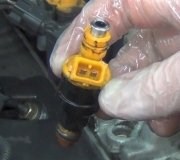Replacing the injector wont solve anything. There is no such fault code related to a mechanical condition. Anything referring to "open" would be an open electrical circuit meaning a break in a wire or no contact between two mating terminals in a connector.
Also be aware fault codes never say to replace parts or that one is bad. They only indicate the circuit or system that needs further diagnosis, or the unacceptable operating condition. When a part like a sensor or injector is referenced in a fault code, it is actually the cause of that code only about half of the time. First you have to rule out wiring and connector problems.
There's a lot of codes related to injectors too. I need to know the exact fault code number, not a generic description of it.
You need to list the symptoms too other than the Check Engine light. If an injector were to stick open, that is not monitored by the Engine Computer. While there is a way to see when the valve opens, and to verify its operation, with a scope, I'm not aware of any Engine Computers that are sophisticated enough to do that and set a fault code. A stuck injector would cause fuel pressure to bleed down within a few seconds after stopping the engine, then you'd have an uncommonly long crank time before the engine would restart. There would be a lot of black smoke from the tail pipe and fuel mileage would be down. Eventually the Engine Computer would see the excessive unburned fuel in the exhaust system. It would flash the Check Engine light to tell you to stop the engine right away to avoid overheating and damaging the expensive catalytic converter.
GM has had a lot of trouble with injectors causing random cylinder misfire codes. Chrysler, and some other manufacturers, buy their injectors from Bosch in flow-matched sets and problems are extremely rare. GM just grabs a handful of injectors out of a big bin and throws them into the engine with no regard to matching their flow rates. With high-mileage, wear and varnish buildup causes one or two to flow less fuel than the others. The cylinders running lean send unburned oxygen into the exhaust where it gets detected as a lean condition. The computer adds more fuel to its metering calculations in an attempt to fix the mixture, and that contributes to lower fuel mileage. A lot of these misfires on GM products are solved by installing a set of flow-matched rebuilt injectors. Never replace just one injector.
Monday, April 6th, 2015 AT 5:49 PM



